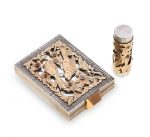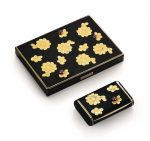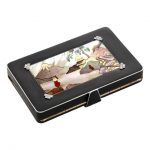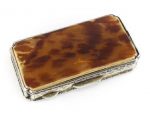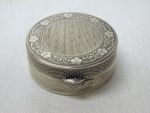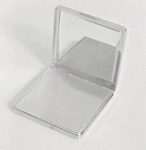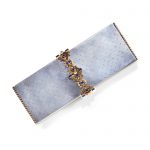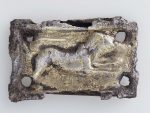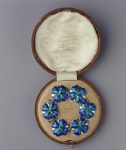Compacts date from the early 1900s, a time when make-up had not gained widespread social acceptance and the first powder cases were often concealed within accessories such as walking sticks, jewellery or hatpins.
From 1896, American handbag manufacturer Whiting & Davis created lidded compartments in its bags where powder rouge and combs could be stowed. In 1908, Sears’ catalogue advertised a silver-plated case with mirror and powder puff (price 19 cents) and described it as small enough to fit in a handbag.
In the US, manufacturers such as Evans and Elgin American produced metal compacts with either finger chains or longer tango chains. Designed to be displayed rather than fitted in a handbag, they required more ornate designs and many from this era are examples of sleek Art Deco styling.
As make-up became more mainstream and women were increasingly active outside the home, compacts became more popular. British manufacturer Stratton began importing part-finished powder boxes from the US for assembly at its Birmingham plant in 1923 and by the 1930s it was creating them from scratch and producing half the compacts used by the UK cosmetics industry. The company developed self-opening inner lids in 1948, designed to protect the powder and prevent damage to fingernails, and by the 1960s it was exporting to agents worldwide. Reference: Wikipedia
BOUCHERON: A French silver, silver-gilt ruby and gem-set compact and matching lipstick signed Boucheron Paris, numbered BT No 875012 and 80433 lozenge shaped maker’s mark, and French boar’s head guarantee mark, mixed metal mark, and ‘OR ARGENT’ Rectangular form with chequered surface, the open-work panel with song birds among leafy branches, gilt angular ribbed thumb piece, opening to reveal mirror and powder compartments, length 8cm, the cylindrical lipstick with similarly decorated open-work sleeve, height 5.4cm. (2)
Sold for £ 750 inc. premium at Bonhams in 2018
A FRENCH ENAMEL AND RUBY-SET PARCEL-GILT SILVER COMPACT AND PILL BOX MARK OF VAN CLEEF & ARPELS, PARIS, CIRCA 1930 Each with scattered inlaid and gilt flowers, the interior of the compact with mirror and compartment, marked three times to interior, also stamped Van Cleef & Arpels 71501; the pillbox marked on flange and base, also stamped 6573 Van Cleef & Arpels 64087 The compact: 3 ½ in. (8.9 cm.) wide, the pillbox: 2 in. (5.1 cm.) wide; 6 oz. 18 dwt. (215 gr.) gross weight
Sold for USD 7,500 at Christies in 2017
Silver Gilt, Platinum, Enamel, Mother-of-Pearl and Diamond Envelope Compact The compact centers a mother-of-pearl & hardstone chinoiserie rectangular panel accented on the four corners by rose-cut diamonds with maker’s mark, ap. 97.7 dwts. With inner fitted suede pouch.
Sold for $2,812 (includes buyer’s premium) at Doyle New York in 2018
Continental Gilt .900 Silver and Shell Miniature Compact c.1920. Hand chased foliate designs throughout. Includes a compartment for powder and with Houbigant lipstick.Measures Approx., 6.25″ x 5″ x 2.5″ inches
Sold for $130 at Taylor & Harris in 2019
European silver compact circa 1900
Reference: The Metropolitan Museum of Art
Powder compact by Asprey Made by Asprey & Co. Limited in Birmingham, West Midlands, England, United Kingdom, Europe, 1940-1950. Square hinged silver powder compact decorated on the outside with fine engine turned undulating lines, a plain border and gilt garland clasp. Inside lid is a beveled mirror within a gilt frame. A hinged inner cover decorated with the same fine engine turned decoration as the exterior opens to reveal the internal gilt surface of the compact.
Reference: Museum of Applied Art and Sciences
Silver, gold and sapphire vanity case, 1950s The sliding central bar clasp highlighted by step- and circular-cut sapphires, opening to reveal a mirror, a lipstick holder and a powder compartment on one side and cigarette compartment on the opposite side, measuring approximately 160 x 60 x 20mm, French assay marks for gold and silver, indistinct maker’s mark, numbered, gross weight approximately 334.10 grams.
Sold for 3,750 EUR at Sothebys in 2018
